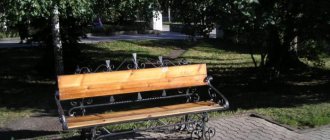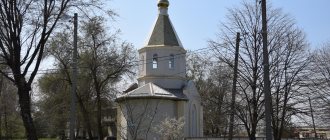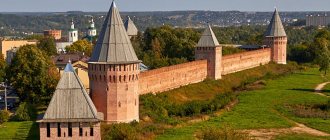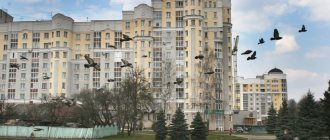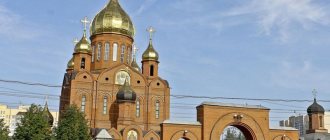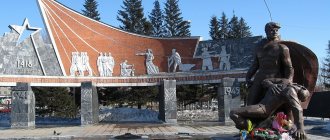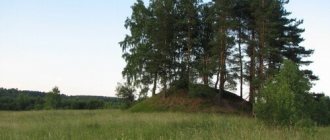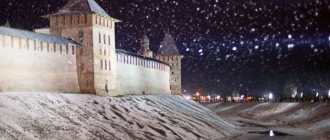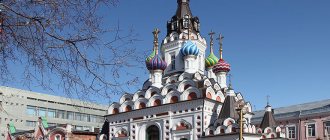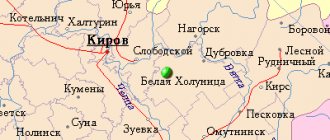author: G.A. Churilova
Chapter I Kursk land in ancient times and during the Middle Ages
§1. The first information about Slavic settlements and ancient cities of the Kursk land.
People have been living on Kursk land since ancient times. The very first traces of settlements of the Upper Paleolithic era (Old Stone Age) date back to the 15th - 20th millennium BC and were found within the city of Kursk in the area of Polevaya and Kotlyakova streets. This was the time of the great glacier in Europe, part of which also captured the Kursk land, which was covered with swampy tundra during this period. The first inhabitants lived in dugouts, dressed in animal skins, and their main occupation was hunting mammoths. During the Neolithic era / New Stone Age, V - III millennium BC / the ice in Europe melted, the climate changed in the Kursk region. The forest-steppe contributed to the development of hunting and fishing, and human settlements were located along the rivers. Neolithic sites were discovered near the Kirov tram bridge over the Tuskar River, in the village of Ryshkovo, on 1st Promyshlennaya Street. in the city of Kursk, near the village of Lebyazhye on the river. Seim, as well as in the vicinity of the oldest city in the region - Rylsk. During the excavations, stone axes, hammers, knives, arrowheads, and clay shards were found. In the Bronze Age /late 3rd - 1st millennium BC/ new human occupations appeared: cattle breeding and agriculture. The first settlements of this time were not yet fortified, people continued to move from place to place. Human sites were discovered along the Tuskar and Seim rivers: at the Kirov Bridge, at the yeast factory, at the tannery. Bronze Age burials were discovered during construction work in the center of Kursk: on Red Square near the Znamensky Cathedral and on the site of the Main Post Office building. The finds date back to the 2nd millennium BC. These were tribes of the Catacomb and then Timber cultures, apparently of Indo-Iranian origin. In addition, in the second half of the 2nd millennium BC. Tribes of the Sosnitsa culture penetrate into the territory of the Kursk region, in which archaeologists see the Proto-Slavs. This is quite likely, since in the Bronze Age Europe was a giant anthill in which many tribes and ethnic groups moved chaotically. And in our forest-steppe zone there were repeated movements, clashes and mergers of various tribal groups.
The origin of the Slavic peoples, including the eastern ones, has always interested scientists. Previously, there were attempts to declare the Slavs as immigrants from Asia, a people alien to the rest of the peoples of Europe. But already in the first half of the 19th century. these views have been refuted. At one time, the Danube theory was popular, according to which the Pannonian Lowland on the Danube was considered the ancestral home of the Slavs.
The main evidence was information from The Tale of Bygone Years. However, studies of archeology and anthropology, the study of historical facts have shown that the area of formation of the Slavic peoples was the lands north of the Carpathian Mountains: the Vistula, Pripyat, and Middle Dnieper basins.
The probable ancestors of the Slavs can be considered the tribes that created the “culture” of burial fields” / late 1st millennium BC - first half of 1st millennium AD / The tribes that created the “culture” of burial fields “lived in unfortified villages, built adobe dwellings with stoves, engaged in cattle breeding and agriculture. They burned the dead, and buried the ashes in pits or in clay vessels buried in the ground in common cemeteries. Hence the name of the culture, otherwise known as the “field of burial urns.” Among these cultures, the most widespread was the Zarubintsy culture, traces of which were found in the Dnieper region and along the Seim and Sozh rivers. It was to the time of its spread that the Roman historians Tacitus and Pliny Suetonius the Elder mentioned the Slavs under the name “Vendi”.
The Early Iron Age occupies the entire 1st millennium BC. During this period, the population of the eastern part of the Kursk Territory was engaged in cattle breeding, and in the western part - farming. Iron smelting begins from numerous deposits of marshy iron ores. In the 7th - 5th centuries. BC. Permanent settlements with fortified walls, ditches, ramparts, and palisades appear, which indicates an aggravation of relations between clans and the beginning of the decomposition of the primitive system.
In the VI - V centuries. BC. and the first settlement appears at the mouth of the Kur and Tuskar rivers - the first Kursk fortress. This is confirmed by clay shards dating back to this time found during excavations in the area of the Officers' House and the electrical equipment plant. The place for the first fortress - the city was chosen successfully by our ancestors: a steep cliff from the side of the present House of Officers with a palisade placed there, a deep ditch with a rampart and a palisade from the side of the local history museum and the Sign Cathedral reliably protected the inhabitants of Pervokursk from enemies. Obviously, about 2500 years ago the city bore the same name. According to linguistics, the name of the Kur River is of Iranian origin. Considering the agricultural and pastoral nature of the occupation of the population of the Kursk region at that time, scientists assumed that “special Scythians” lived here and were part of the Scythian kingdom. However, archaeologists have established that the Kursk people in the 1st millennium BC. Plow farming was developed, while the “special Scythians” used hoes to grow fodder crops. And plow farming was developed among those peoples who sowed rye and wheat, including for sale. The remoteness of the Kursk region from ancient trade routes suggests that plow farming was brought to us from outside. And the only place where it was developed was the Middle Dnieper region, the cradle of Russian statehood. Therefore, it can be assumed that the settlement was in the 6th -5th centuries. BC. It could well have been Slavic. Moreover, the moment of the founding of Pervokursk falls on the period of the last Scythian campaigns against the Slavic Middle Dnieper region and the reconciliation of these related Indo-European peoples. Scythia, turning into a large slave-holding state, was tired of endless wars with its neighbors. In turn, the Eastern Slavs also went far in the processes of class formation, and, back in the 6th century BC, 1500 years before the formation of Kievan Rus, our ancestors came close to creating a state. And after 512 BC, after a joint victory over King Darius, the Scythians and Slavs became so close that their contemporary Herodotus could hardly distinguish them in everyday life and in clothing.
However, the Pervokursk fortress did not last long, and, due to the Sarmatian invasion in the 2nd century BC, people left all the settlements. The Sarmatians destroyed the Skolot “kingdoms” - the oldest Russian early state associations, therefore the Slavs in the 3rd century. BC. - I century AD represented by the Zarubintsy culture, which is quite primitive and primitive. But already in the first half of the 1st millennium AD. in the west and in the middle part of the Kursk region lived tribes of a high culture at that time, called Chernyakhov by archaeologists. Traces of the Chernyakhov culture were discovered near the village of Mokva and the village of Lebyazhye near Kursk.
The Chernyakhov culture completely replaced the Zarubinets culture, leaving no trace of it. A number of historians of pre-revolutionary times explained this by the fact that the Chernyakhovites were a warlike people, that they were Goths, Dacians, Scythians, but not Slavs. But it seems possible to accept the point of view of other historians who consider the Chernyakhovites only Slavs. Kursk local historian Yu. A. Lipking proposed considering the Chernyakhovites a conglomerate of different peoples united under the influence of high Roman culture, which could contribute to the degeneration of the Zarubinets culture into the Chernyakhov culture. But by this time, according to the testimony of Pliny the Elder, the Sarmatian yoke no longer weighed on the Slavs. The Veneds themselves went on the offensive and drove the Sarmatians to the Balkans, where they were defeated and exterminated by the Romans. Some Sarmatians mixed with the Scythians and Slavs, so the Sarmatian element in the Chernyakhov culture is very low. But the Dacian element is high. After the conquest of Dacia in 106, part of the local population “emigrated” to the new Scythian-Slavic Rus', unable to withstand Roman oppression. This is evidenced by the rise of plow farming. Middle Dnieper region.
The Goths could not have been the creators of the Chernyakhov culture, since they appeared at the turn of the 3rd - 4th centuries. and had a low level of development. However, by force of arms they manage to create an alliance of tribes, under the leadership of Germanarich, who fell in 375 under the blows of the Huns. However, Attila, the leader of the Huns, was unable to destroy the Chernyakhov culture, although he led it to decline.
On the territory of the Kursk Territory, Chernyakhov settlements existed until the 5th-6th centuries. There are no monuments of them in the region, since they did not live in fortified settlements, but many rich treasures and Roman coins of this period are found throughout the Kursk region.
Numerous movements and assimilation of various tribes and peoples of the era of the “Great Migration of Peoples” at the turn of the 1st millennium BC. and the beginning of the I-II century. AD led to the deep penetration of tribes to the east along the Seversky Donets and south to the lower reaches of the Dnieper, to the formation of new tribal unions, the emergence of new peoples and states.
The last Chernyakhov settlers of the Kursk region subsequently merged with part of the Vyatichi and began to be called northerners. It is also possible for individual Finno-Ugric tribes with their own culture to penetrate into the Kursk region, the features of which are noted by Rylsk local historian O.N. Shchegolev in the anthology “The City of Rylsk” /Kursk, 1994/, calling the Kolochin culture the next culture after Chernyakhov’s.3 But, obviously, the Kolochin Finns were completely assimilated by the Slavic tribes by the 8th century, when the Kursk region was covered with a chain of Romny fortresses-fortifications, located in clear chains from the southeast along the river banks. There are five of these lines-fortresses in total, and between them there remains an almost empty space in which there are one or two fortifications. It is quite possible that the Romny settlements are a unified defense system for the eastern borders of Kievan Rus. This is a completely plausible assumption, although it diverges from the traditional countdown of Russian history from 862.
Over the long years of their reign, the Kieviches accumulated enormous wealth in their hands and, possessing strong power, were able to carry out such events as the storming of Constantinople in 630, and in 787 Kiev fought a war in the Crimea, where Slavic troops under the leadership of Prince Bravlin captured Sudak fortress. At the same time, a stone fortress was founded in Ladoga. Thus, the Grand Duke of Kiev could well have financed the construction of defensive lines in the east of the principality. Moreover, in the VI century. The Seversky lands were included in the Kyiv principality of the Polyan-Rusyns.
Part of the so-called Romny fortresses was the Kursk fortress, which re-emerged in the 8th century. at the mouth of the river Chicken It was a small settlement, protected and fortified by a ditch, rampart and palisade, which went from the cliff of the Tuskar River to the ravine running down to the Kur. There were three to four dozen half-dugout huts in the settlement. The time of the founding of the fortress is confirmed by finds of fragments of Slavic ceramics that existed in the 8th-10th centuries.
The formation of Kursk as a city coincided with the Khazar conquests of the Seversk land. According to historians V.O. Klyuchevsky and L.N. Gumilyov, the Khazar “occupation” of the Seversky region opened the way for many Russian merchants to the largest trading markets of the East. And in Kursk, trade has long been greatly developed. The city lay at the intersection of the most important river routes at that time. The first led to Kursk from Kyiv through the Dnieper, Desna, and Seim. The second path went along Tuskari and Snova to Lake Samodurovskoye, which disappeared over time. From here the path opened to the upper reaches of the Volga, to the Neva and the Baltic. The third path led to the upper reaches of the Seim and from there, through a small portage, to the Seversky Donets, and then to the Don, to the Azov and Black Seas.
Correlating these data with archaeological finds, we can assume that in the 9th century. Kursk can be considered a city in the modern sense, as a center of trade, pottery, crafts, metallurgy and other industries. At the end of the 10th century. Rylsk was founded as a fortress city of the Kyiv state on the site of an ancient settlement in the 8th century. Obviously, the city got its name from the Rylo River, at the confluence of which with the Seim the city stands. An ancient legend explains the name of the river this way: when a wild pig and piglets were digging a lair for themselves, they dug up a source, which was the beginning of the river. The same pig, the legend goes on, went to Sevsk, laying a flat road, which later received the name Pig Road. Apparently, under the influence of this legend, a boar’s head on a golden field was subsequently depicted on the ancient coat of arms of the city.
In the north-west of the Kursk region, in close proximity to the places where the famous Bryansk forests originate, on the right bank of the formerly deep Svapa River, not far from the city of Dmitriev, an ancient settlement of the 8th-9th centuries has been preserved. Ancient Dmitriev was located about two kilometers below the modern city, where the village of Old Town is now, located, as local residents say, “on five hills.” These “five hills” were subsequently placed at the bottom of the coat of arms of the city of Dmitriev. On one of these hills there was a fortified settlement, bordered by deep ravines and an earthen rampart. The area of the settlement is about two hectares. The perimeter is more than 550 meters. In the center of the fort there was a secret passage through which one could go down to Svapa and go outside the fortress.
On the territory of the present Belovskoso district of the Kursk region, located in the southern part of the region, archaeologists of the 19th-20th centuries. D.Ya. Samokvasov, B.A. Rybakov, local historians Yu.A. Lipking, L.N. Preobrazhenin 6 examined 26 mounds and settlements dating back to the early Slavic period. The largest and most interesting of them is the Gochev settlement, dating back to the 9th-10th centuries. Moreover, Yu.A. Lipking proved his argument based on research that it was here, on the site of the Gochev settlement, that the disappeared legendary Slavic city of Rimov, mentioned in “The Tale of Igor’s Campaign,” was located. The city was destroyed by the Polovtsians in 1185. “Behold, Rome is shouting under the Polovtsian sabers,” this is how the author of the Lay spoke of the terrible picture of the destruction of the city by the Polovtsians. During this period, many cities appeared in Kievan Rus. But the Kievichs were defeated in the fight against the Norman group led by Rurik, who seized power in the northern Russian lands. In 882, the Varangian king Oleg /Holger/ captured Kyiv and united Kievan and Novgorod Rus'. After Oleg’s successful campaigns against the Khazars in 884, the Seversky lands were included in the new state.
TABLE OF CONTENTS
Your comment:
Up ▲ — Reader reviews (2) — Write a review ▼ — Print version
| e-mail, city: Krasnodar | |
Very interesting and informative. Thank you, I'll be happy to read the sequel.
| Klimkov Sergey Valentinovich | 4 June 2022, 16:07:29 |
| e-mail, city: Vladimir | |
settlements in the northern and central parts of European Russia appeared a very long time ago. This is evidenced by the Vladimir Sungir, which, by the way, has not been fully explored due to the development of the city in the area of the village. Kind. All the same, they were probably not yet Slavs in the form that most ordinary people now understand, but they were (I’m talking about the Kuryans) people who laid down the gene pool of the Slavs along with the tribes living on the territory of Novgorod and Pskov. Arkhangels, Suzdal.

